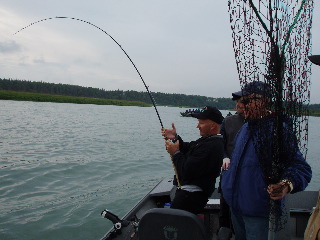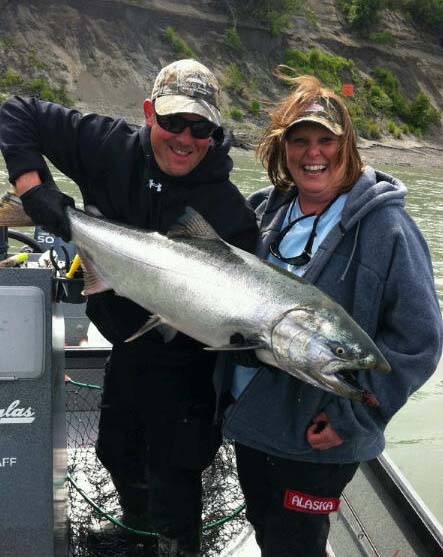
23 Jan Kenai Kings – What to Expect
With big Kenai Kings, knowing what to expect is half the battle!
It happened just like it always does. The side rod creaked for a millisecond and then gets buried in the rod holder. The idle chatter and relaxed atmosphere of bobbing around on the river is poignantly interrupted by a king salmon just minutes from the ocean and well over 70 pounds. As the rod is finally wrestled from the holder it has less than half the spool left and the chase is on. Despite extraordinary efforts to keep the tip up and the line tight, it all seems like a dream. No matter how fast you turn the reel, the fish is too erratic to control and in the first several minutes of the battle the line is only tight for a few seconds. Soon the fish charges the boat and departs from the water into a violent catapult that triggers a collective gasp among all the boats in the immediate area. Then without warning or choice the fish pins the rod to the side of the boat and the hook comes loose. This entire sequence lasted perhaps 3-4 minutes, but it was more adrenaline than most are accustomed to in a lifetime. The first question is always… “what’d I do wrong…?” The answer is probably a lot of things. The truth is a number of factors are beyond our control and to a certain extent it’s either meant to be or it’s not. This said, a certain degree of preparation will definitely go a long way toward preparing you for what to expect once that moment of chaos is upon you.
What to expect…
When you enter the boat to go king fishing, your guide will greet you and will likely be anxious to cover some basics before you begin fishing. Remember that on the Kenai, guides are restricted to fishing between the hours of 6:00AM to 6:00PM Tuesday through Saturday. This is why we meet at 5:30AM, to make sure there is time to meet, greet, check fishing licenses, fill out our ADF&G log books, give a safety briefing, cover a few basics about the fishing AND be on the water and in position to fish at 6:00AM sharp. Being on time and ready to go is very important, especially if you are not the only party on the boat that day. As you will be driving and meeting your guide at one of many given Kenai River launches, it helps to find your meet place the night prior to your trip. This will make it much easier in the morning. If you do not have time the night before to check out the launch, allowing a few extra minutes that morning is always a good idea. At peak times, there is considerable congestion at many of the main launches and one should allow plenty of time to park the car, pay applicable parking fees, and make their way to the boat. Did you remember your fishing license? Don’t be the guy driving back to the cabin while everyone else in your group goes fishing.
As you make your way to the river to meet your guide, keep in mind that all Kenai River guide boats have individual identification numbers. When you check in the night prior to your trip, we will often tell you your guide’s boat number so that you can easily find them. Many of our launches will have only a handful of boats present or your guide will know and find you. There are times, especially in July on the lower river, where there will be multiple boats and multiple anglers all trying to meet at the same time and in the same place. It helps to expect and be aware of this. Again, allowing extra time in the morning will go a long way toward making sure the whole trip gets off to a great start.
Okay, so you’ve located your guide and you’ve boarded the boat. It’s important to remember Alaska is a wet place in the summer. Even if it is a nice sunny morning, it may have rained the night prior or the guide may have washed his boat seat and they could still be wet. In any event, be ready for the possibility of a wet seat by wearing waterproof clothes. This can be breathable Gore-Tex or regular poly raingear and it will not only keep your bottom dry, it will shield you from the wind, rain, bait (salmon eggs are messy) and fish slime when you are holding up that 50 pound king for a picture. If you brought a backpack or a cooler, your guide will help you stow it so that it is out of the way. With your raingear on and gear put away, it’s time to take a seat. The guide may prefer you sit in certain places for weight distribution, but unless otherwise notified, just find a seat and settle in. After checking fishing licenses and giving a safety briefing, the guide will be ready to roll. Most of the time you will be just a short run to the fishing grounds so zip that jacket and off you go.
If you have never fished the Kenai for king salmon before, it is certainly worth doing a little homework to familiarize yourself on what to expect. For those that have fished the Kenai in the past, refreshing yourself on this unique fishery will certainly not hinder your effort. The first thing to expect or remember about Kenai king fishing, especially in July, is competition. Seeing multiple boats fishing the same section of river is fairly common but before you get discouraged by your fellow anglers consider that more baits in the water often encourages more fish to bite. This is especially true in tidal reaches of the Kenai where salmon are more congregated. When a big group of Kenai kings decide to migrate upriver, they do not like things getting in their way and much like sharks, once one starts getting aggressive, it encourages like behavior. On the water you can see when the fish arrive and begin biting as nets will pop up all around until finally your rod is the one pinned down in the holder and it’s your turn. Even though you naturally hope to catch a king on the Kenai, remember many do not. You may see fish being caught all around you, but keep the numbers in mind. With dozens of boats, all with multiple lines in the water, it is not uncommon to always look around and see a fish on somewhere, maybe even two or three at once. As only a finite number of fish will bite on any given day or tide cycle, you just need to be there and be ready and from there: fate must take its course.
So here it is, the moment of truth. You’ve been on the river for several hours and were beginning to think today would not be your day when your rod fattens out in the holder and line starts peeling off the reel (just like the guide told you would happen!). Something very large roils the surface behind the boat and by now you have the rod in hand and can feel the direct power of a huge king fighting for its freedom. For many, this millisecond of contact with the fish of their dreams may be the closest they get to making it all come true. Indeed the Kenai king is a tough fish to tame and many spend their entire lives learning how to properly battle these oversized salmon. Understanding some of the more important aspects or facets to the fight will certainly help to avoid losing the fish unnecessarily.
Here’s a few basic tips:
1. Tight Line!
This may seem obvious to any type of fishing but believe it or not slack line is likely the single most common reason for “long line” releases of Kenai kings. With a big river, a strong current, and a monster king, keeping the line taunt is easier said than done. The most effective method for eliminating slack line is to REEL! Even if line is coming off the reel, turning the handle is never a bad idea. This is especially important when the fish is well away from the boat as the more line you have in the water, the more likely you are to have slack line. Keep reeling without stopping until the guide tell you to stop. Remembering this important tip can make the difference between the thrill of victory or the agony of defeat.
2. Load the rod!
Many people may not understand what this means. Imagine someone holding the tip of your rod firmly between their fingers and then pulling up on the handle until the rod won’t possibly bend another inch. This fulcrum or sweet spot in every rod is where true angler do their best work. It is the place where you will find the most powerful leverage against whatever’s at the end of your line. If you are fighting a fish with your rod fully loaded (doubled over to the backbone), chances are good that your line is tight and the hook is firm in the fish’s mouth. This is 90% of the battle so the longer you keep the rod loaded up , the more likely you are to win the fight. Just how does one go about making sure the rod is always loaded to the backbone? See tip #1.
3. Keep that tip still!
Speaking of tips, did you know that the more your tip wiggles in the course of a fight, the more likely you are to wear a hole in the fishes mouth and the more likely the hook is to FALL OUT! Makes sense right.? If you were standing in your backyard practicing your skills and got the hook caught in a tree, what would you do to instinctively free the hook. You’d wiggle the tip. Keep this in mind when you are fighting that big king. Many people are so enthralled with reeling that they fail to control unnecessary rod shake. Consistent tip wiggle combined with a little slack line is a bad combo on the Kenai.
4. Don’t Panic!
I think one of the most interesting things that we as guides get to see is people just plain losing all composure. Keep in mind we see a little bit of everything in our occupation and it’s really hard to judge a book by the cover when trying to predict how a certain individual will react to a chaotic situation: namely doing battle with a big Kenai king. Tense muscles, shaking knees and super heavy breathing are all common occurrences out on the river and as a guide, a big part of our job is to calm the angler down and remind them “you can do it, just take a deep breath, keep reeling and don’t panic.”
5. Listen to the guide and not “Uncle Fred.”
Most guides care deeply about how well you do as they love what they do and want to be successful as well. If you can drop any previous fishing pretence you may have and truly listen to the guide and all of his/her advice while on his/her boat, this will help you greatly. Hopefully reading the above information will come in handy when indeed it is your turn to take on a trophy Kenai King Salmon. Realistically, unless you’ve done it multiple times, it will be a somewhat intimidating experience. There are so many factors that are really beyond your control that even if you were lucky or skilled enough to do everything exactly right, the river and the fish can have their own master plan. The bottom line is they just don’t all come to the net but if you have faith in your guide, stay calm and most importantly… listen to his or her instructions, chances are you’ll win the battle and land the fish.

